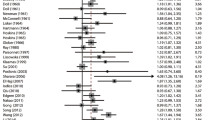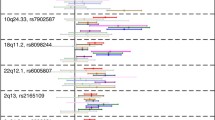Abstract
Purpose
Previous studies have examined the association between ABO blood group and ovarian cancer risk, with inconclusive results.
Methods
In eight studies participating in the Ovarian Cancer Association Consortium, we determined ABO blood groups and diplotypes by genotyping 3 SNPs in the ABO locus. Odds ratios and 95 % confidence intervals were calculated in each study using logistic regression; individual study results were combined using random effects meta-analysis.
Results
Compared to blood group O, the A blood group was associated with a modestly increased ovarian cancer risk: (OR: 1.09; 95 % CI: 1.01–1.18; p = 0.03). In diplotype analysis, the AO, but not the AA diplotype, was associated with increased risk (AO: OR: 1.11; 95 % CI: 1.01–1.22; p = 0.03; AA: OR: 1.03; 95 % CI: 0.87–1.21; p = 0.76). Neither AB nor the B blood groups were associated with risk. Results were similar across ovarian cancer histologic subtypes.
Conclusion
Consistent with most previous reports, the A blood type was associated modestly with increased ovarian cancer risk in this large analysis of multiple studies of ovarian cancer. Future studies investigating potential biologic mechanisms are warranted.
Similar content being viewed by others
References
American Cancer Society (2010) Cancer facts and figures 2010. American Cancer Society, Atlanta
Ferlay J, Shin HR, Bray F, Forman D, Mathers C, Parkin DM (2010) Estimates of worldwide burden of cancer in 2008: GLOBOCAN 2008. Int J Cancer 127(12):2893–2917
Bjorkholm E (1984) Blood group distribution in women with ovarian cancer. Int J Epidemiol 13:15–17
Henderson J, Seagroatt V, Goldacre M (1993) Ovarian cancer and ABO blood groups. J Epidemiol Community Health 47:287–289
Osborne RH, Degeorge FV (1963) The Abo blood groups in neoplastic disease of the ovary. Am J Hum Genet 15:380–388
Vogel F (1970) Controversy in human genetics. ABO blood groups and disease. Am J Hum Genet 22:464–475
Gates MA, Wolpin BM, Cramer DW, Hankinson SE, Tworoger SS (2011) ABO blood group and incidence of epithelial ovarian cancer. Int J Cancer 128:482–486
Daniels G (2009) The molecular genetics of blood group polymorphism. Hum Genet 126:729–742
Goode EL, Chenevix-Trench G, Song H et al (2010) A genome-wide association study identifies susceptibility loci for ovarian cancer at 2q31 and 8q24. Nat Genet 42:874–879
Pearce CL, Near AM, Van Den Berg DJ et al (2009) Validating genetic risk associations for ovarian cancer through the international Ovarian Cancer Association Consortium. Br J Cancer 100:412–420
Terry KL, Tworoger SS, Goode EL et al (2010) MTHFR polymorphisms in relation to ovarian cancer risk. Gynecol Oncol 119:319–324
Pare G, Chasman DI, Kellogg M et al (2008) Novel association of ABO histo-blood group antigen with soluble ICAM-1: results of a genome-wide association study of 6,578 women. PLoS Genet 4:e1000118
Wolpin BM, Kraft P, Xu M et al (2010) Variant ABO blood group alleles, secretor status, and risk of pancreatic cancer: results from the pancreatic cancer cohort consortium. Cancer Epidemiol Biomarkers Prev 19:3140–3149
Song H, Ramus SJ, Tyrer J et al (2009) A genome-wide association study identifies a new ovarian cancer susceptibility locus on 9p22.2. Nat Genet 41:996–1000
Garratty G, Glynn SA, McEntire R (2004) ABO and Rh(D) phenotype frequencies of different racial/ethnic groups in the United States. Transfusion 44:703–706
Wolpin BM, Kraft P, Gross M et al (2010) Pancreatic cancer risk and ABO blood group alleles: results from the pancreatic cancer cohort consortium. Cancer Res 70:1015–1023
Barbalic M, Dupuis J, Dehghan A et al (2010) Large-scale genomic studies reveal central role of ABO in sP-selectin and sICAM-1 levels. Hum Mol Genet 19:1863–1872
Paterson AD, Lopes-Virella MF, Waggott D et al (2009) Genome-wide association identifies the ABO blood group as a major locus associated with serum levels of soluble E-selectin. Arterioscler Thromb Vasc Biol 29:1958–1967
Qi L, Cornelis MC, Kraft P et al (2010) Genetic variants in ABO blood group region, plasma soluble E-selectin levels and risk of type 2 diabetes. Hum Mol Genet 19:1856–1862
Acknowledgments
We thank all members of the UKOPS research team, including research nurses, research scientists, data entry personnel, and consultant gynecological oncologists for their help in establishing the UKOPS case–control collection. In particular, we thank Aleksandra Gentry Maharaj, Usha Menon, Ian Jacobs, Eva Wozniak, Andy Ryan, and Jeremy Ford. The NHS and NHSII thank the following state cancer registries for their help: AL, AZ, AR, CA, CO, CT, DE, FL, GA, ID, IL, IN, IA, KY, LA, ME, MD, MA, MI, NE, NH, NJ, NY, NC, ND, OH, OK, OR, PA, RI, SC, TN, TX, VA, WA, and WY. The MAY study thanks Christopher Hilker and Jason Vollenweider for iSelect genotyping. OCAC: funded through the Ovarian Cancer Research Fund thanks to donations by the family and friends of Kathryn Sladek Smith; MAY: NIH R01 CA122443 and NIH P50 CA136393, funding from the Mayo Foundation; NCO: NIH R01 CA76016 and Department of Defense DAMD17-02-1-0666; NEC: NIH R01 CA54419, NIH P50 CA105009, and Department of Defense grant W81XWH-10-1-0280; NHS: NIH T32 CA009001, NIH P01 CA87969, NIH R01 CA49449, NIH R01 CA50383, and NIH R01 CA67262; POL: supported by the Intramural Research Program of the NIH, National Cancer Institute, Division of Cancer Epidemiology and Genetics, and the Center for Cancer Research; TBO: NIH R01 CA106414, ACS CRTG-00-196-01-CCE, Department of Defense grant DAMD17-98-1-8659, and the Celma Mastry Ovarian Cancer Foundation.; TOR: grants from the Canadian Cancer Society, NIH R01 CA63682, NIH R01 CA63678, and NIH R01 CA080978; UKG: The UKOPS ovarian cancer case–control study is funded by a grant from the Oak Foundation. Additional research was funded by a charitable donation from UCLH special trustees, The Eve Appeal, Cancer Research UK project grant (no. C8804/A7058), a Medical Research Council Grant (MRC28209), and a European Commission Seventh Framework Program grant agreement #223175 (HEALTH-F2-2009-223175). Some of this work was undertaken at University College Hospital, London, which receives a proportion of its funding from the UK Department of Health’s National Institute for Health Research Biomedical Research Centre funding scheme..
Conflict of Interest
The authors declare that they have no conflict of interest.
Author information
Authors and Affiliations
Corresponding author
Electronic supplementary material
Below is the link to the electronic supplementary material.
Rights and permissions
About this article
Cite this article
Poole, E.M., Gates, M.A., High, B.A. et al. ABO blood group and risk of epithelial ovarian cancer within the Ovarian Cancer Association Consortium. Cancer Causes Control 23, 1805–1810 (2012). https://doi.org/10.1007/s10552-012-0059-y
Received:
Accepted:
Published:
Issue Date:
DOI: https://doi.org/10.1007/s10552-012-0059-y




